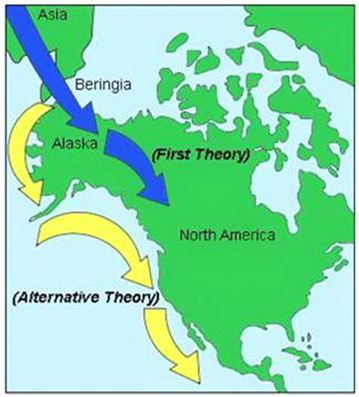托福阅读常考话题及练习题推荐一:冰川(1)
托福阅读常考话题:冰川
Passage 1
Colonizing the Americas via the Northwest Coast

It has long been accepted that the Americas were colonized by a migration of peoples from Asia, slowly traveling across a land bridge called Beringia (now the Bering Strait between northeastern Asia and Alaska) during the last Ice Age. The first water craft theory about this migration was that around 11,000-12,000 years ago there was an ice-free corridor stretching from eastern Beringia to the areas of North America south of the great northern glaciers. It was this midcontinental corridor between two massive ice sheets–the Laurentide to the east and the Cordilleran to the west–that enabled the southward migration. But belief in this ice-free corridor began to crumble when paleoecologist Glen MacDonald demonstrated that some of the most important radiocarbon dates used to support the existence of an ice-free corridor were incorrect. He persuasively argued that such an ice-free corridor did not exist until much later, when the continental ice began its final retreat.
Support is growing for the alternative theory that people using watercraft, possibly skin boats, moved southward from Beringia along the Gulf of Alaska and then southward along the Northwest coast of North America possibly as early as 16,000 years ago. This route would have enabled humans to enter southern areas of the Americas prior to the melting of the continental glaciers. Until the early 1970s,most archaeologists did not consider the coast a possible migration route into the Americas because geologists originally believed that during the last Ice Age the entire Northwest Coast was covered by glacial ice. It had been assumed that the ice extended westward from the Alaskan/Canadian mountains to the very edge of the continental shelf, the flat, submerged part of the continent that extends into the ocean. This would have created a barrier of ice extending from the Alaska Peninsula, through the Gulf of Alaska and southward along the Northwest Coast of north America to what is today the state of Washington.
The most influential proponent of the coastal migration route has been Canadian archaeologist Knut Fladmark. He theorized that with the use of watercraft, people gradually colonized unglaciated refuges and areas along the continental shelf exposed by the lower sea level. Fladmark’s hypothesis received additional support form from the fact that the greatest diversity in native American languages occurs along the west coast of the Americas, suggesting that this region has been settled the longest.
More recent geologic studies documented deglaciation and the existence of ice-free areas throughout major coastal areas of British Columbia, Canada, by 13,000 years ago. Research now indicates that sizable areas of southeastern Alaska along the inner continental shelf were not covered by ice toward the end of the last Ice Age. One study suggests that except for a 250-mile coastal area between southwestern British Columbia and Washington State, the Northwest Coast of North America was largely free of ice by approximately 16,000 years ago. Vast areas along the coast may have been deglaciated beginning around 16,000 years ago, possibly providing a coastal corridor for the movement of plants, animals, and humans sometime between 13,000 and 14,000 years ago.
The coastal hypothesis has gained increasing support in recent years because the remains of large land animals, such as caribou and brown bears, have been found in southeastern Alaska dating between 10,000 and 12,500 years ago. This is the time period in which most scientists formerly believed the area to be inhospitable for humans. It has been suggested that if the environment were capable of supporting breeding populations of bears, there would have been enough food resources to support humans. Fladmark and other believe that the first human colonization of America occurred by boat along the Northwest Coast during the very late Ice Age, possibly as early as 14,000 years ago. The most recent geologic evidence indicates that it may have been possible for people to colonize ice-free regions along the continental shelf that were still exposed by the lower sea level between13,000 and 14,000 years ago.
The coastal hypothesis suggests an economy based on marine mammal hunting, saltwater fishing, shellfish gathering, and the use of watercraft. Because of the barrier of ice to the east, the Pacific Ocean to the west, and populated areas to the north, there may have been a greater impetus for people to move in a southerly direction.
托福阅读常考话题:冰川练习题
【段落主旨】
Paragraph 1:
Paragraph 2:
Paragraph 3:
Paragraph 4:
Paragraph 5:
Paragraph 6:
【生词摘录】

索取“完整内容+练习题”,请加新航道上海老师微信(shnc_2018)









